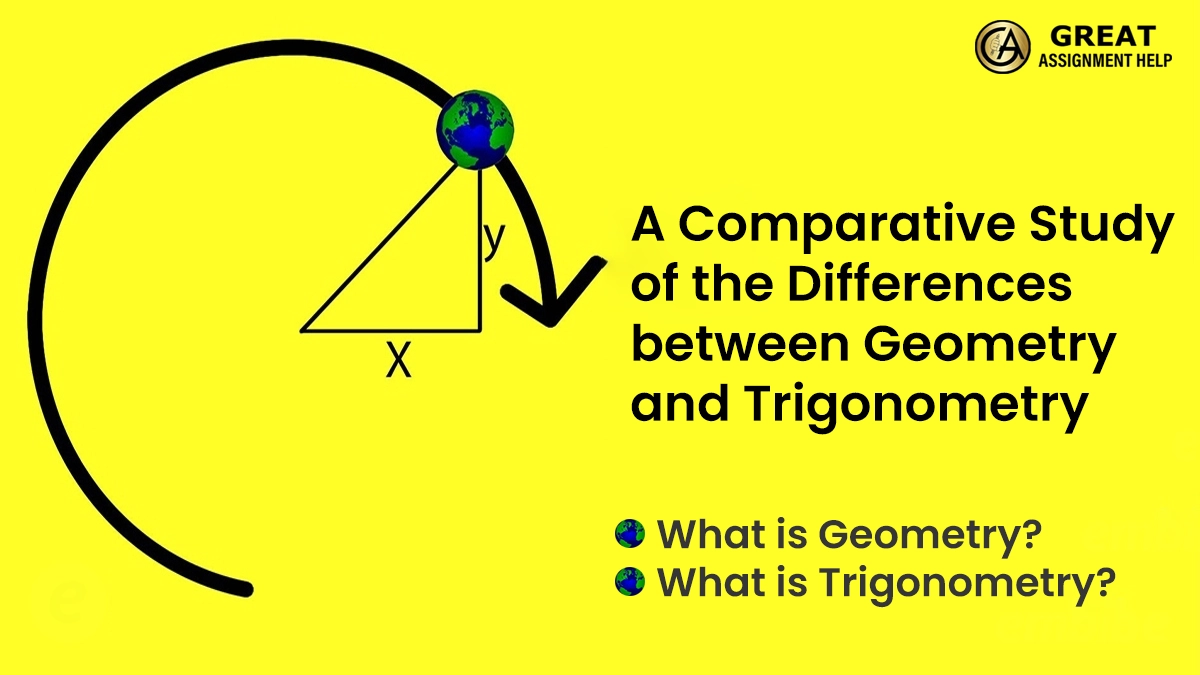Geometry and Trigonometry are both essential parts of mathematics and are extensively used in practical life. However, there are no similarities between them. Geometry studies figures, while trigonometry deals with the properties of triangles. But most students confuse the concepts, uses, and features of these mathematical branches. If you have blurry ideas about the disparities between geometry vs. trigonometry, read this blog. Here, we have conducted an exhaustive study of these mathematical branches.
A Comparative Study of the Differences between Geometry and Trigonometry
Following are the differences between geometry and trigonometry:
Geometry vs. Trigonometry: Concept
Here are the differences between geometry and trigonometry in terms of the concept:
- What is Geometry?
Geometry is the branch of mathematics that studies the features of a space, for example, the distance, shape, size, and overall position of a figure. It is one of the oldest branches of mathematics.
- What is Trigonometry?
Trigonometry is one of the primary branches of mathematics. It is concerned with the angles and ratio of length, especially in a right-angle triangle. Therefore, it helps to identify the unknown or missing angles or sides of a triangle with the help of trigonometric formulas, functions, or identities.
Geometry vs. Trigonometry: Formula
Geometry and trigonometry use different formulas to find the values. Here is the difference between them:
- Geometry
Following are the basic formulas of geometry:
- Perimeter of a Square = P = 4a
Here, a = the length of the sides of a square.
- Perimeter of a Rectangle = P = 2(l+b)
Here, l = Length and b = breadth.
- Area of a Square = A = a2
Here, a = the length of the sides of a square.
- Area of a Rectangle = A = l×b
Here, l = length, and b = Breadth.
- Area of a Triangle = A = ½×b×h
Here, b = the base of the triangle, and h is the height of the triangle.
- Area of a Trapezoid = A = ½×(b1 + b2)×h
Here b1 & b2 are the bases of the trapezoid, and h = height of the trapezoid.
- Area of a Circle = A = π×r2.
- The circumference of a Circle = A = 2πr.
Here, r = A circle’s radius.
- A Cube’s Surface Area = S = 6a2.
Here, a = a Cube’s length of the sides
- A Cylinder’s curved surface area = 2πrh.
- A Cylinder’s total surface area = 2πr(r + h).
- The volume of a Cylinder = V = πr2h.
Here, r = the radius of the Cylinder’s base, and h = the height of the Cylinder.
- A cone’s curved surface area = πrl.
- A cone’s total surface area = πr(r+l) = πr[r+√(h2+r2)].
- The volume of a Cone = V = ⅓×πr2h.
Here, r = the radius of the base of the Cone, and h = the height of the Cone.
- A Sphere’s Surface Area = S = 4πr2.
- The volume of a Sphere = V = 4/3×πr3.
Here, r = the radius of the Sphere.
- Trigonometry
Formulas used in geometry are based on basic trigonometric functions and reciprocal identities.
Also read: Arithmetic vs. Mathematics: An Analysis of the Differences
Basic Trigonometric Function Formulas
To find elements in trigonometry, 6 ratios are used. They are called trigonometric functions. Considering a right-angled triangle as a reference, the following trigonometric functions and identities are derived:
- sin θ = Opposite Side/Hypotenuse
- cos θ = Adjacent Side/Hypotenuse
- tan θ = Opposite Side/Adjacent Side
- sec θ = Hypotenuse/Adjacent Side
- cosec θ = Hypotenuse/Opposite Side
- cot θ = Adjacent Side/Opposite Side
Reciprocal Identities
The Reciprocal Identities are mentioned as follows:
- cosec θ = 1/sin θ
- sec θ = 1/cos θ
- cot θ = 1/tan θ
- sin θ = 1/cosec θ
- cos θ = 1/sec θ
- tan θ = 1/cot θ
Geometry vs. Trigonometry: Area of Study
Geometry and Trigonometry deal with 2 completely different areas. Find the difference between their areas of study below.
- Geometry: Geometry deals with shapes, lines, planes, and points. It concentrates on exploring the connection between various shapes. You can calculate all probable shapes by utilizing geometry and its theories.
- Trigonometry: It deals with triangles only. Even in circumstances where you have only two lines and one angle, trigonometry uses imaginary lines to sketch a triangle and resolves the problem.
Geometry vs. Trigonometry: Study of properties
Geometry and Trigonometry study different types of properties. Here is the difference between them:
- Geometry: Geometry studies geometrical figures. It can be a simple structure like a line, or a complex structure, for example, hexagon- geometry. Additionally, it studies different types of triangles, like right-angle, equilateral, acute, obtuse, etc.
- Trigonometry: Trigonometry is concerned with only one type of geometrical shape, which is a triangle. Specifically, trigonometry explores the features of a right-angle triangle.
Geometry vs. Trigonometry: Subset and Superset
Geometry and trigonometry are not completely independent. Among the two, one is a superset of the other.
- Geometry: It is the branch of mathematics that covers geometric calculations, theories, and formulas. If compared with trigonometry, it can be called a superset of trigonometry since geometry deals with all shapes and forms of triangles.
- Trigonometry: It is a subset of geometry. Unless the geometric angles are formed, trigonometry cannot explore the right-angle triangles.
Geometry vs. Trigonometry: Properties Considered To Derive Values
Geometry and trigonometry consider different properties to derive the values.
- Geometry: It studies the properties of angles and measures their sides to derive the values.
- Trigonometry: It only measures the angles to draw the values.
Read more: What is a Variable in Math, its Types and Uses?
Geometry vs. Trigonometry: Branches
Geometry and trigonometry are categorized into various branches. However, they are not the same.
- Geometry
It is divided into three categories:
- Plane geometry: All shapes that are available on a flat surface are covered by plane geometry.
- Spherical geometry: It deals with shapes that are similar to any circle.
- Solid geometry: It is concerned with three-dimensional shapes.
- Trigonometry
It is categorized into 4 categories:
- Core trigonometry: It deals with right-angle triangles with the help of sine and cosine functions.
- Plane trigonometry: It determines a plane triangle’s height and distance.
- Spherical trigonometry: It analyses the measurement of a triangle on a sphere.
- Analytical geometry: It is concerned with the use of a coordinate system to manipulate various functions in trigonometry. It helps to obtain formulas for use in various engineering and scientific applications.
Geometry vs. Trigonometry: History
Both geometry and trigonometry originated in Greece. However, they were introduced by different mathematicians at different times.
- Geometry: Euclid is called the father of geometry. He introduced the subject in 3000 BC.
- Trigonometry: The Famous Greek mathematician Hipparchus introduced Trigonometry in the year 190 BC.
Geometry vs. Trigonometry: Uses in Real Life
Geometry and trigonometry have widespread uses in everyday life. They play an essential role in every sector of the economy, from building a house to sketching a piece of art.
- Geometry: Geometry is employed in creating video games, designing robots, building structures like monuments, and sports utilities for soccer, badminton, cricket, baseball, etc. The shape and the weight of the objects used in these games, for example a cricket bat determine its strength to hit a ball that comes in high speed.
- Trigonometry: Trigonometry is not for the use of a common man. Usually, specialists like scientists, mathematicians, and academicians use trigonometry. NASA takes the help of trigonometry to launch rockets and spaceships into space. Similarly, geologists measure the height of mountains and their position and animators determine the movement of objects in graphic-heavy games through trigonometry.
Geometry vs. Trigonometry: Related Terminologies
The terms used to denote geometry and trigonometry are different. Here are the differences between the two branches of mathematics in terms of related terminologies:
- Geometry: It is defined with the words Geometrical and Geometer
- Trigonometry: Terms like Trigonometric and trigonometric define trigonometry.
Geometry vs. Trigonometry: Derivation
The terms geometry and trigonometry are derived from different Greek words. Following is the difference in their derivation.
- Geometry: The term geometry is a combination of two Greek words. Geo: It indicates earth and Metron: It means measure.
- Trigonometry: Trigonometry is a combination of the two Greek terms, Trigon, the triangle, and Metron, the measure.
Geometry vs. Trigonometry: Which Of The Two Is More Difficult?
Everybody has their learning capabilities and interests. It makes a subject appear easier. However, the overall observation of multiple students is the same.
- Geometry: Geometry requires simple thinking abilities to find the answer.
- Trigonometry: It requires a higher level of thinking to master the concept and get the value.
Also read: Best Math Books To Augment Your Skills
A Tabular Representation of the Differences between Geometry and Trigonometry
| Basis of Difference | Geometry | Trigonometry |
| Concept | It is the branch of mathematics that deals with spatial relations. In simple words, it is concerned with explicit properties like spherical and more. | Trigonometry is a mathematical branch that offers information on angles and the sides of triangles by calculating trigonometric functions. |
| Related terminologies | Geometrical and Geometer are the connected terms that are employed to define the geometry word. | Trigonometry is described with the terms trigonometric and trigon. |
| Derivation | “Geometry” is the culmination of the Greek words: “Geo” means Earth, and “Metron” means measure. | “Trigonometry” is developed from the Greek words “Trigonon”, meaning triangle, and “metron”, meaning measure. |
| Subset and superset | Geometry is believed to be the superset of trigonometry. | Trigonometry is considered a subset of geometry. |
| Uses | Geometric concepts are employed for structuring buildings, dams, roads, rivers, and temples. It is also used in Computer Graphics, Art, Interior Design, Measuring Orbits, planetary motions, etc. | Concepts of Trigonometry help study to decide the angle of inclination of the roof. It is also helpful in the naval and aviation industries. |
| Formula | The fundamental formulas of geometry are:
· Perimeter of a Square = P = 4a · Perimeter of a Rectangle = P = 2(l+b) · Area of a Square = A = a2 · Area of a Rectangle = A = lb · Area of a Triangle = A = 12bh12bh · 12(b1b2)h12(b1· Area of a Trapezoid = A = ½×(b1 + b2)h · Area of a Circle = A = r2r2 · Circumference of a Circle = A = 2r2r · A Cube Surface Area = S = 6a2 · A Cylinder’s curved surface area = 2rh2rh · A Cylinder’s total surface area = 2r(r2r(r + h) · Volume of a Cylinder = V = r2hr2h · A cone’s curved surface area = πrl · A cone’s total surface area = r(r+l) = r[r+(h2+r2r[r+(h2+r2)] · The volume of a cone = V = 13r2hThe volume of a cone = V = 13r2h · A Sphere’s Surface Area = S = 4πr2 · Volume of a Sphere = V = 4/3r34/3r3
|
Following are the basic formulas of trigonometry:
· sin θ = Opposite Side/Hypotenuse · cos θ = Adjacent Side/Hypotenuse · tan = Opposite Side/Adjacent Sidetan = Opposite Side/Adjacent Side · sec θ = Hypotenuse/Adjacent Side · cosec θ = Hypotenuse/Opposite Side · cot θ = Adjacent Side/Opposite Side |
| Area of Study
|
Geometry is concerned with shapes, lines, planes, and points. | It is concerned with triangles. |
| Study of properties | Geometry investigates the characteristics of all forms of geometrical figures. | Trigonometry examines only triangle shaped objects. |
| Subset and superset | It is a superset of trigonometry. | It is a subset of geometry. |
| Properties considered to derive values | It considers the features of angles and measures to get the derived values. | It only measures the angles to get the derived values. |
| Types | It is divided into three types:
plane, solid, and spherical geometry |
It is divided into four types: core, plane, spherical, and analytical trigonometry. |
| History | It was developed in 3000 BC by the famous mathematician Euclid. | The Greek mathematician Hipparchus developed in 190 BC. |
| Level of difficulty | It is less difficult. | It is more difficult. |
The Bottom Line
We hope you have now gained a complete understanding of geometry vs. trigonometry. In general, geometry and trigonometry are parts of elementary mathematics. Moreover, they are also the foundations of many intricate branches of mathematics. Therefore, it is important to know about the basic concepts of geometry and trigonometry. If you need more information on the subject to understand the disparities deeply or need help solving geometry or trigonometry homework problems, connect with our assignment helper. They will offer accurate solutions with detailed steps within the deadline you set.



